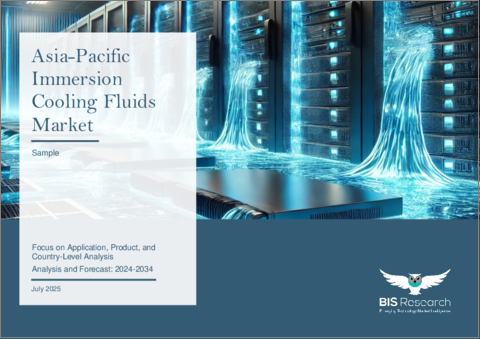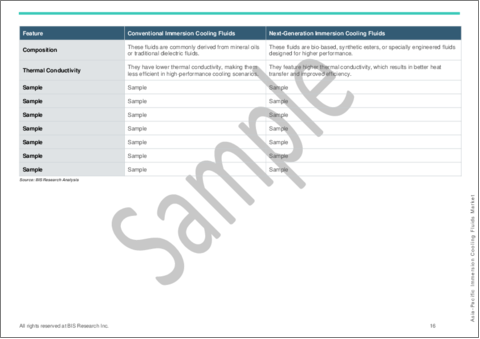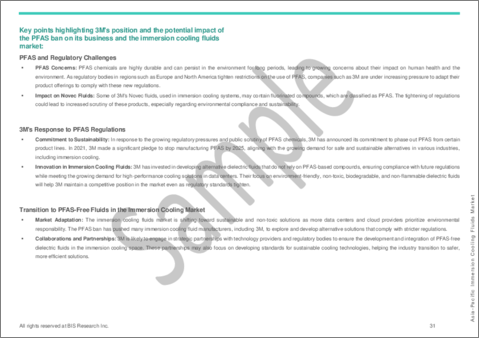|
|
市場調査レポート
商品コード
1769476
アジア太平洋の液浸冷却液市場:用途別、製品別、国別 - 分析と予測(2024年~2034年)Asia-Pacific Immersion Cooling Fluids Market: Focus on Application, Product, and Country-Level Analysis - Analysis and Forecast, 2024-2034 |
||||||
カスタマイズ可能
|
|||||||
| アジア太平洋の液浸冷却液市場:用途別、製品別、国別 - 分析と予測(2024年~2034年) |
|
出版日: 2025年07月14日
発行: BIS Research
ページ情報: 英文 82 Pages
納期: 1~5営業日
|
全表示
- 概要
- 図表
- 目次
アジア太平洋の液浸冷却液の市場規模は、2024年には4,255万米ドルとなり、26.45%のCAGRで拡大し、2034年には4億4,462万米ドルに達すると予測されています。
アジア太平洋市場で販売される液浸冷却液は、IEC、RoHS、REACHなどの国際規格に沿った現地法の適用を受ける。流体が地域の性能、安全性、持続可能性基準を満たすことを保証するために、中国、日本、シンガポールなどの国々は、化学的安全性、燃焼性、環境への影響に関する厳しい規制を課しています。
| 主要市場統計 | |
|---|---|
| 予測期間 | 2024年~2034年 |
| 2024年の評価 | 4,255万米ドル |
| 2034年の予測 | 4億4,462万米ドル |
| CAGR | 26.45% |
市場イントロダクション
アジア太平洋における液浸冷却液市場は、データセンターインフラの成長、高性能コンピューティング需要の高まり、持続可能性とエネルギー効率への関心の高まりにより、急速に拡大しています。従来の空冷や水冷に比べ、ITハードウェアやパワーエレクトロニクスを熱伝導性があるが非導電性の流体に浸す液浸冷却は、熱性能の向上、電力使用効率(PUE)の低下、運用コストの削減など、いくつかのメリットをもたらします。
半導体の生産、エッジコンピューティング、電気自動車(EV)、およびハイパースケールデータセンターは、採用を推進している重要な分野です。5GネットワークやAIのワークロードがアジア太平洋全域に広がるにつれ、高度な熱管理システムの必要性が高まっています。中国、日本、インド、シンガポールなどの国々では、持続可能性に関する法律、グリーン・データセンター・プロジェクト、政府の優遇措置に後押しされ、この分野をリードしています。
地域の気候や規制要件に適した次世代、生分解性、誘電性流体は、この地域のメーカーによってますます開発されています。しかし、高額な初期投資、標準化の欠如、サプライチェーンの複雑さは依然として問題です。浸漬型冷却液は、アジア太平洋がよりエコロジーに配慮し、スケーラブルで効率的なデジタル・産業インフラに移行する上で極めて重要な役割を果たすと予想されるため、こうした障害にもかかわらず、市場の見通しは明るいです。
市場セグメンテーション
セグメンテーション1:用途別
- データセンター
- ハイパースケール
- コロケーション
- エンタープライズ
- その他
- 電気自動車
- 乗用車
- 商用車
- 産業機器
- エネルギー・発電システム
- 通信機器
- 軍事・航空宇宙
- 舶用電力システム
- その他
セグメンテーション2:化学分野別
- フルオロカーボンベース浸漬冷却液
- 鉱物油ベースの浸漬冷却液
- 合成エステル
- 水性液
- その他
セグメンテーション3:製品別
- 単相クーラント
- 二相クーラント
セグメント4:地域別
- アジア太平洋:中国、日本、インド、韓国、オーストラリア、その他
アジア太平洋の液浸冷却液市場動向と促進要因・課題
市場動向
- エネルギー効率の改善とPUE削減を目的としたアジア太平洋データセンターにおける液浸冷却技術の急速な採用
- 持続可能性が地域の事業者の最優先事項となる中、環境に優しく生分解性のある流体処方への注目が高まる
- AIやエッジコンピューティングの導入に液浸冷却を統合し、ネットワークエッジにおける高密度ワークロードの熱ニーズに対応
- 高密度コンピューティング(5Gインフラ、ブロックチェーンマイニング)へのシフトが高度な熱管理流体への需要を促進
- 地域固有の配合を開発するアジア太平洋のローカルサプライヤーの開発により、競争が激化し、エンドユーザーのコストが低下する可能性
主な促進要因
- 中国、シンガポール、日本における厳しいエネルギー効率規制(PUE目標1.3以下など)が液浸冷却の導入に拍車をかけている
- アジア太平洋全域におけるハイパースケールデータセンターへの大規模投資
- アジア太平洋におけるEV市場(中国を除く)の急拡大により、バッテリーの熱管理における液浸冷却の大きな出口が生まれる
- 高熱EUVリソグラフィ装置用の超高純度誘電体流体を必要とするこの地域の先端半導体工場の成長
- 次世代流体の研究開発を促進し、業界とのパートナーシップを奨励する政府の優遇措置と協力関係
市場の課題
- 高い初期投資(空冷の最大50%増)と互換性の問題が中小企業の足かせ
- 特殊化学品のサプライチェーンが複雑で、特定の単相流体のリードタイムが6ヶ月以上かかる
- 流体の回収、精製、リサイクルのための標準化されたプロセスが欠如しているため、使用終了時の環境およびコストに関する懸念がある
- 労働力のスキル不足-技術者の多くが液浸に特化したトレーニングを受けていないため、配備が遅れ、メンテナンスコストが上昇
- アジア太平洋には統一された業界標準がないため、流体、ラック、ITハードウェア間の統合のハードルと互換性のリスクがある
製品/イノベーション戦略:アジア太平洋の液浸冷却液市場の製品セグメントは、データセンター、ハイパフォーマンスコンピューティング、電気自動車などの産業における様々な用途に焦点を当てています。コンパクトで高密度なシステムの放熱を効率的に管理するように設計された先進的な冷却液が含まれます。主要技術には、冷却効率を向上させエネルギー消費を削減する、特別に配合された熱伝導性流体が含まれます。エネルギー効率の高い持続可能な冷却ソリューションへの需要が高まる中、液浸冷却液市場は、流体技術の革新と、高性能化する電子システムにおける最適化された熱管理の必要性により、高い成長機会をもたらす可能性があります。
成長/マーケティング戦略:アジア太平洋の液浸冷却液市場は急速に拡大しており、既存市場参入企業と新興市場参入企業の双方に大きな機会を提供しています。主な戦略としては、M&A、製品投入、パートナーシップ、提携、事業拡大などが挙げられます。この市場に参入している企業は、市場ポジションを維持・強化するため、製品の革新と開発に注力する傾向にあります。
競合戦略:当レポートでは、技術プロバイダーを含むアジア太平洋の液浸冷却液市場における主要企業プロファイルを掲載しています。提携、合意、協力関係を含む競合情勢の包括的な見解を提供し、読者が市場において未開拓の収益機会を特定するのに役立ちます。
当レポートでは、アジア太平洋の液浸冷却液市場について調査し、市場の概要とともに、用途別、製品別、国別の動向、および市場に参入する企業のプロファイルなどを提供しています。
目次
エグゼクティブサマリー
第1章 市場:業界展望
- 液浸冷却液市場:現状と将来
- サプライチェーンの概要
- 研究開発レビュー
- 規制状況
- 浸漬冷却液製品仕様概要(用途別)
- 浸漬冷却液の化学と組成
- PFAS禁止シナリオ
- 市場力学:概要
第2章 地域
- 液浸冷却液市場(地域別)
- アジア太平洋
- 市場
- 応用
- 製品
- アジア太平洋(国別)
第3章 市場-競合ベンチマーキングと企業プロファイル
- 今後の見通し
- 市場シェア分析
- 競合ベンチマーキング
- 製品価格の動向と分析
- 液浸冷却液の価格に影響を与える要因
- 浸漬冷却液と従来の冷却方法の費用対効果分析
- 企業プロファイル
- ENEOS Corporation
第4章 調査手法
List of Figures
- Figure 1: Asia-Pacific Immersion Cooling Fluids Market (by Scenario), $Million, 2023, 2027, and 2034
- Figure 2: Asia-Pacific Immersion Cooling Fluids Market (by Application), $Million, 2023, 2027, and 2034
- Figure 3: Asia-Pacific Immersion Cooling Fluids Market (by Chemistry), $Million, 2023, 2027, and 2034
- Figure 4: Asia-Pacific Immersion Cooling Fluids Market (by Product), $Million, 2023, 2027, and 2034
- Figure 5: Key Events
- Figure 6: Companies Advancing Immersion Cooling Solutions
- Figure 7: Electric Car Market Share, %, 2023
- Figure 8: Electric Car Stock, Millions, 2020-2023
- Figure 9: Supply Chan and Risks within the Supply Chain
- Figure 10: Value Chain Analysis
- Figure 11: Patent Analysis (by Country), January 2021-February 2025
- Figure 12: Patent Analysis (by Company), January 2021-February 2025
- Figure 13: Impact Analysis of Market Navigating Factors, 2024-2034
- Figure 14: Energy Consumption Breakdown in AI Data Centers
- Figure 15: Renewable energy demand growth (by Electricity), in EJ, 2023-2030
- Figure 16: Share of Total 5G Mobile Connections (by Region), 2023 and 2030
- Figure 17: China Immersion Cooling Fluids Market, $Million, 2023-2034
- Figure 18: Japan Immersion Cooling Fluids Market, $Million, 2023-2034
- Figure 19: India Immersion Cooling Fluids Market, $Million, 2023-2034
- Figure 20: South Korea Immersion Cooling Fluids Market, $Million, 2023-2034
- Figure 21: Australia Immersion Cooling Fluids Market, $Million, 2023-2034
- Figure 22: Rest-of-Asia-Pacific Immersion Cooling Fluids Market, $Million, 2023-2034
- Figure 23: Strategic Initiatives, January 2021-March 2025
- Figure 24: Estimated Capital Expense for Various Data Center Cooling Technologies
- Figure 25: Data Triangulation
- Figure 26: Top-Down and Bottom-Up Approach
- Figure 27: Assumptions and Limitations
List of Tables
- Table 1: Market Snapshot
- Table 2: Opportunities across Region
- Table 3: Trends: Overview
- Table 4: Comparison Between Conventional and Next-Generation Immersion Cooling Fluids
- Table 5: Government Regulations Impacting Immersion Cooling Fluids
- Table 6: Environmental Regulatory Landscape for Fluids
- Table 7: Industry Certifications and Standards for Immersion Cooling Fluids
- Table 8: Immersion Cooling Fluids Product Specifications (by Application)
- Table 9: Regulatory Landscape for PFAS Ban Scenario
- Table 10: Regulatory Landscape for Future Policy Changes and Recommendations
- Table 11: 3M's PFAS-Based Immersion Cooling Fluids: Key Products and Applications
- Table 12: Immersion Cooling Fluids Market (by Region), $Million, 2023-2034
- Table 13: Asia-Pacific Immersion Cooling Fluids Market (by Application), $Million, 2023-2034
- Table 14: Asia Pacific Immersion Cooling Fluids Market (by Chemistry), $Million, 2023-2034
- Table 15: Asia-Pacific Immersion Cooling Fluids Market (by Product Type), $Million, 2023-2034
- Table 16: China Immersion Cooling Fluids Market (by Application), $Million, 2023-2034
- Table 17: China Immersion Cooling Fluids Market Market (by Chemistry), $Million, 2023-2034
- Table 18: China Immersion Cooling Fluids Market (by Product Type), $Million, 2023-2034
- Table 19: Japan Immersion Cooling Fluids Market (by Application), $Million, 2023-2034
- Table 20: Japan Immersion Cooling Fluids Market (by Chemistry), $Million, 2023-2034
- Table 21: Japan Immersion Cooling Fluids Market (by Product Type), $Million, 2023-2034
- Table 22: India Immersion Cooling Fluids Market (by Application), $Million, 2023-2034
- Table 23: India Immersion Cooling Fluids Market (by Chemistry), $Million, 2023-2034
- Table 24: India Immersion Cooling Fluids Market (by Product Type), $Million, 2023-2034
- Table 25: South Korea Immersion Cooling Fluids Market (by Application), $Million, 2023-2034
- Table 26: South Korea Immersion Cooling Fluids Market Market (by Chemistry), $Million, 2023-2034
- Table 27: South Korea Immersion Cooling Fluids Market (by Product Type), $Million, 2023-2034
- Table 28: Australia Immersion Cooling Fluids Market (by Application), $Million, 2023-2034
- Table 29: Australia Immersion Cooling Fluids Market (by Chemistry), $Million, 2023-2034
- Table 30: Australia Immersion Cooling Fluids Market (by Product Type), $Million, 2023-2034
- Table 31: Rest-of-Asia-Pacific Immersion Cooling Fluids Market (by Application), $Million, 2023-2034
- Table 32: Rest-of-Asia-Pacific Immersion Cooling Fluids Market (by Chemistry), $Million, 2023-2034
- Table 33: Rest-of-Asia-Pacific Immersion Cooling Fluids Market (by Product Type), $Million, 2023-2034
- Table 34: Market Share, 2023
- Table 35: Influencing Factors for Immersion Cooling Fluid Prices
This report can be delivered in 2 working days.
Introduction to Asia-Pacific Immersion Cooling Fluids Market
The Asia-Pacific immersion cooling fluids market was valued at $42.55 million in 2024 and is expected to grow at a CAGR of 26.45%, reaching $444.62 million by 2034. Immersion cooling fluids sold in the APAC market are subject to local laws that are in line with international standards such as IEC, RoHS, and REACH. To guarantee that fluids satisfy regional performance, safety, and sustainability standards, nations like China, Japan, and Singapore impose stringent regulations on chemical safety, flammability, and environmental effect.
| KEY MARKET STATISTICS | |
|---|---|
| Forecast Period | 2024 - 2034 |
| 2024 Evaluation | $42.55 Million |
| 2034 Forecast | $444.62 Million |
| CAGR | 26.45% |
Market Introduction
The market for immersion cooling fluids in Asia-Pacific (APAC) is growing quickly due to the region's growing data centre infrastructure, rising high-performance computing demand, and growing focus on sustainability and energy efficiency. Compared to conventional air and water cooling, immersion cooling-which entails immersing IT hardware or power electronics in thermally conductive but non-electrically conductive fluids-offers several benefits, such as improved thermal performance, lower power usage effectiveness (PUE), and lower operating costs.
The production of semiconductors, edge computing, electric vehicles (EVs), and hyperscale data centres are important sectors propelling adoption. Advanced thermal management systems are becoming increasingly necessary as 5G networks and AI workloads spread throughout Asia-Pacific. Leading the way are nations like China, Japan, India, and Singapore, aided by sustainability laws, green data centre projects, and government incentives.
Next-generation, biodegradable, and dielectric fluids that are suited to regional climate and regulatory requirements are being developed by manufacturers in the area more and more. High upfront expenditures, a lack of standardisation, and supply chain complexity are still issues, though. The market prognosis is positive despite these obstacles, as immersion cooling fluids are anticipated to be crucial to APAC's shift to digital and industrial infrastructure that is more ecologically conscious, scalable, and efficient.
Market Segmentation:
Segmentation 1: by Application
- Data Center
- Hyperscale
- Colocation
- Enterprise
- Others
- Electric Vehicles
- Passenger Vehicles
- Commercial Vehicles
- Industrial Equipment
- Energy and Power Generation Systems
- Telecommunications
- Military and Aerospace
- Marine Power Systems
- Others
Segmentation 2: by Chemistry
- Fluorocarbon-Based Immersion Cooling Fluids
- Mineral Oil-Based Immersion Cooling Fluids
- Synthetic Esters
- Water-Based Fluids
- Others
Segmentation 3: by Product
- Single-Phase Coolant
- Two-Phase Coolant
Segmentation 4: by Region
- Asia-Pacific: China, Japan, India, South Korea, Australia, and Rest-of-Asia-Pacific
APAC Immersion Cooling Fluids Market Trends, Drivers and Challenges
Market Trends
- Rapid adoption of immersion cooling technology in APAC data centers to improve energy efficiency and reduce PUE
- Growing focus on eco-friendly, biodegradable fluid formulations as sustainability becomes a top priority for regional operators
- Integration of immersion cooling into AI and edge-computing deployments, addressing the thermal needs of high-density workloads at the network edge
- Shift toward high-density computing (5G infrastructure, blockchain mining) driving demand for advanced thermal management fluids
- Emergence of local APAC suppliers developing region-specific formulations-heightening competition and potentially lowering end-user costs
Key Drivers
- Stringent energy-efficiency regulations in China, Singapore and Japan (e.g., PUE targets below 1.3) spurring immersion cooling uptake
- Massive investments in hyperscale data centers across APAC, where immersion fluids are key to managing rising power densities
- Rapid expansion of the EV market (excluding China) in APAC, creating a sizable outlet for immersion cooling in battery-thermal management
- Growth of advanced semiconductor fabs in the region, demanding ultra-pure dielectric fluids for high-heat EUV lithography equipment
- Government incentives and collaborations promoting R&D in next-gen fluids and encouraging industry partnerships
Market Challenges
- High upfront investment (up to 50% more than air cooling) and compatibility issues that deter small and mid-sized enterprises
- Complex supply chains for specialty chemicals, leading to lead times of six months or more for certain single-phase fluids
- Lack of standardized processes for fluid recovery, purification and recycling, raising environmental and cost concerns at end of life
- Workforce skill gaps-many technicians lack immersion-specific training, slowing deployments and raising maintenance costs
- Absence of unified industry standards in APAC, causing integration hurdles and compatibility risks between fluids, racks and IT hardware
How can this report add value to an organization?
This report can add value to an organization in several ways. Some of these are given here:
Product/Innovation Strategy: The product segment of the APAC immersion cooling fluids market highlights various applications across industries, such as data centers, high-performance computing, and electric vehicles. It includes advanced cooling fluids designed to efficiently manage heat dissipation in compact, high-density systems. Key technologies involve specially formulated thermally conductive fluids, which improve cooling efficiency and reduce energy consumption. As the demand for energy-efficient, sustainable cooling solutions rises, the immersion cooling fluids market could present a high-growth opportunity driven by innovations in fluid technology and the need for optimized thermal management in increasingly powerful electronic systems.
Growth/Marketing Strategy: The APAC immersion cooling fluids market is rapidly expanding, offering substantial opportunities for both established and emerging market players. Key strategies covered include mergers and acquisitions, product launches, partnerships, collaborations, and business expansions. Companies in this market tend to focus on product innovation and development to maintain and strengthen their market position.
Competitive Strategy: The report profiles key players in the APAC immersion cooling fluids market, including technology providers. It offers a comprehensive view of the competitive landscape, including partnerships, agreements, and collaborations, helping readers identify untapped revenue opportunities in the market.
Table of Contents
Executive Summary
Scope and Definition
1 Market: Industry Outlook
- 1.1 Immersion Cooling Fluids Market: Current and Future
- 1.1.1 Advancements in Heat Transfer Fluids and Next-Generation Materials
- 1.1.2 Increase in Electric Vehicle Sales
- 1.1.3 Integration with Renewable Energy Solutions
- 1.2 Supply Chain Overview
- 1.2.1 Value Chain Analysis
- 1.2.2 Who Supplies Whom for Immersion Cooling Fluids Market
- 1.3 Research and Development Review
- 1.3.1 Patent Filing Trend (by Country and Company)
- 1.4 Regulatory Landscape
- 1.4.1 Government Regulations Impacting Immersion Cooling Fluids
- 1.4.2 Environmental Regulations for Fluids and Their Impact
- 1.4.3 Future Policy Changes and Recommendations
- 1.5 Immersion Cooling Fluids Product Specification Overview (by Applications)
- 1.6 Immersion Cooling Fluids Chemistry and Composition
- 1.6.1 Chemical Properties of Immersion Cooling Fluids
- 1.6.2 Thermal Conductivity and Heat Transfer Characteristics
- 1.6.3 Fluid Stability and Longevity
- 1.6.4 Environmental and Safety Considerations
- 1.6.5 Viscosity, Density, and Other Performance Specifications
- 1.7 PFAS Ban Scenario
- 1.7.1 Impact of PFAS on Immersion Cooling Fluids
- 1.7.2 Future Policy Changes and Recommendations
- 1.7.3 3M's Response to the PFAS Ban and Its Impact on the Immersion Cooling Fluids Market
- 1.8 Market Dynamics: Overview
- 1.8.1 Market Drivers
- 1.8.1.1 Rising Enterprise Adoption of Data Center GPUs for High-Performance Computing Applications
- 1.8.1.2 Increasing Focus on Retrofitting and Brownfield Projects
- 1.8.2 Market Restraints
- 1.8.2.1 Increased Costs Arising from System Failures and Fluid Leaks
- 1.8.2.2 Negative Environmental Concerns about Fluorocarbons
- 1.8.3 Market Opportunities
- 1.8.3.1 Expansion of Renewable Energy Projects
- 1.8.3.2 Advancements in 5G and 6G Technologies
- 1.8.1 Market Drivers
2 Regions
- 2.1 Immersion Cooling Fluids Market (by Region)
- 2.2 Asia-Pacific
- 2.2.1 Market
- 2.2.1.1 Key Market Participants in Asia-Pacific
- 2.2.1.2 Business Drivers
- 2.2.1.3 Business Challenges
- 2.2.2 Application
- 2.2.3 Product
- 2.2.4 Asia-Pacific (by Country)
- 2.2.4.1 China
- 2.2.4.1.1 Application
- 2.2.4.1.2 Product
- 2.2.4.2 Japan
- 2.2.4.2.1 Application
- 2.2.4.2.2 Product
- 2.2.4.3 India
- 2.2.4.3.1 Application
- 2.2.4.3.2 Product
- 2.2.4.4 South Korea
- 2.2.4.4.1 Application
- 2.2.4.4.2 Product
- 2.2.4.5 Australia
- 2.2.4.5.1 Application
- 2.2.4.5.2 Product
- 2.2.4.6 Rest-of-Asia-Pacific
- 2.2.4.6.1 Application
- 2.2.4.6.2 Product
- 2.2.4.1 China
- 2.2.1 Market
3 Markets - Competitive Benchmarking & Company Profiles
- 3.1 Next Frontiers
- 3.1.1 Market Share Analysis
- 3.1.2 Competitive Benchmarking
- 3.2 Product Pricing Trends and Analysis
- 3.2.1 Factors Influencing Immersion Cooling Fluids Pricing
- 3.2.2 Cost-Benefit Analysis of Immersion Cooling Fluids vs. Traditional Cooling Methods
- 3.3 Company Profiles
- 3.3.1 ENEOS Corporation
- 3.3.1.1 Overview
- 3.3.1.2 Top Products/Product Portfolio
- 3.3.1.3 Top Competitors
- 3.3.1.4 End-Use Applications
- 3.3.1.5 Key Personnel
- 3.3.1.6 Analyst View
- 3.3.1.7 Market Share, 2023
- 3.3.1 ENEOS Corporation
4 Research Methodology
- 4.1 Data Sources
- 4.1.1 Primary Data Sources
- 4.1.2 Secondary Data Sources
- 4.1.3 Data Triangulation
- 4.2 Market Estimation and Forecast





